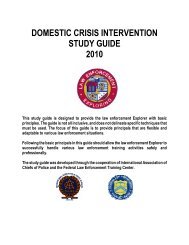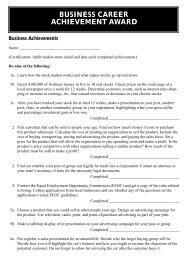ARREST AND SEARCH TECHNIQUES STUDY ... - Learning for Life
ARREST AND SEARCH TECHNIQUES STUDY ... - Learning for Life
ARREST AND SEARCH TECHNIQUES STUDY ... - Learning for Life
Create successful ePaper yourself
Turn your PDF publications into a flip-book with our unique Google optimized e-Paper software.
taken to be searched after a Customs Canine En<strong>for</strong>cement Officer's dog alerted on his vehicle <strong>for</strong>narcotics. In the search room the elderly man shot two officers. One of the injured officersreturned fire and stopped the attack. His shots killed the suspect.In addition to the prior list, there are also a number of articulable verbal and nonverbal signalsthat indicate an assault is probable or even imminent. Assessing behavior and preventing aphysical assault should be accomplished whenever possible. It is critical <strong>for</strong> an officer torecognize and assess aggressive verbal and physical actions of a person. Recognizing verbal andnonverbal aggressive behavior signals will aid the officer in preventing and de-escalatingsituations. Also, it prepares the officer mentally and physically to take immediate counter actionsshould a physical assault occur.Be<strong>for</strong>e physical action by an aggressor occurs, that individual usually begins to threaten toattack, in an attempt to intimidate the opponent, through a process sometimes called posturing,ritualized combat, or affective aggression. These “pre-assault indicators” are listed below. Thisis not an all-inclusive list:• Verbal aggression - yelling, swearing, etc.• A change in posture - stands taller, sets head and shoulders, moves away/moves closer,points, <strong>for</strong>ms fist and/or loads the arm.• Face becomes red, lips separate to show teeth, breathing becomes faster, and perspirationappears on the skin.• Individual ignores others, looks away or stares through people.• Creates a false sense of security by becoming very cooperative or acting incapacitated.• Aggression redirected to something/someone else, such as breaking pencils,kicking, chairs, yelling at bystanders• Individual's stance changes - blades body, lowers center of gravity, shifts weight.• Lips become tight as breathing, though still rapid, deepens. The face loses its flush tobecome pale.• Hands tighten, open or closed, arms and shoulders will shift.• Individual may bob or rock while shifting eyes to possible targets.• Individual may stop all motion in defiance.• Head will come down, chin tucked, eyebrows tightened and dropped.RESPONSES BASED UPON THREAT ASSESSMENTPosition of advantageOfficers should position themselves so they have a position of advantage over those persons theycontact. Threat assessment is the key to determining which position of advantage an officershould use. Positions of advantage can provide safety but must be balanced with efficiency. Forexample, when issuing the driver of a vehicle a speeding ticket the officer notices a weapon. It islikely that he will go from a position of low hands ready to a position of cover/distance and ahigh ready (pistol) position. Why not take the position of cover be<strong>for</strong>e seeing the weapon?Safety vs. efficiency, he cannot issue routine traffic tickets from behind cover. However, bybeing alert he can maximize his safety even during face-to-face encounters. Remember an4








